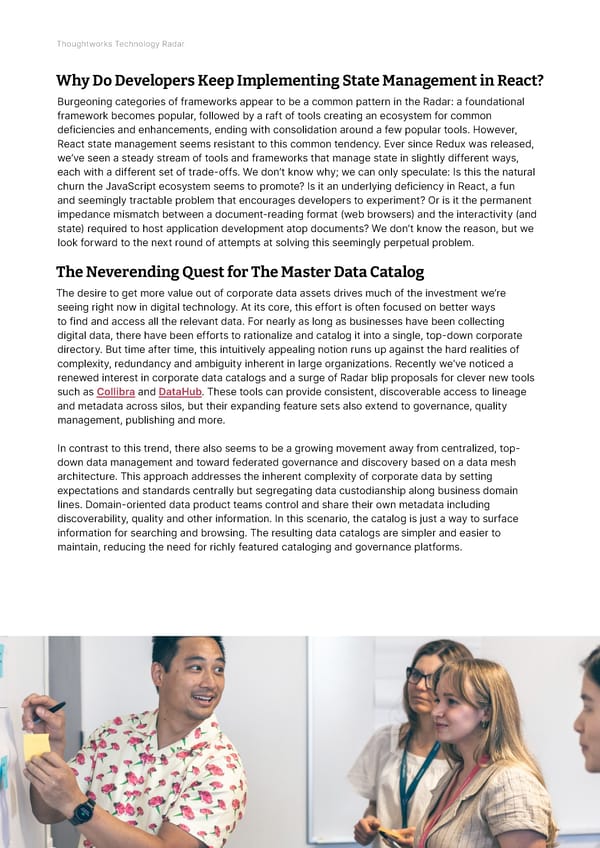Thoughtworks Technology Radar Why Do Developers Keep Implementing State Management in React? Burgeoning categories of frameworks appear to be a common pattern in the Radar: a foundational framework becomes popular, followed by a raft of tools creating an ecosystem for common deficiencies and enhancements, ending with consolidation around a few popular tools. However, React state management seems resistant to this common tendency. Ever since Redux was released, we’ve seen a steady stream of tools and frameworks that manage state in slightly different ways, each with a different set of trade-offs. We don’t know why; we can only speculate: Is this the natural churn the JavaScript ecosystem seems to promote? Is it an underlying deficiency in React, a fun and seemingly tractable problem that encourages developers to experiment? Or is it the permanent impedance mismatch between a document-reading format (web browsers) and the interactivity (and state) required to host application development atop documents? We don’t know the reason, but we look forward to the next round of attempts at solving this seemingly perpetual problem. The Neverending Quest for The Master Data Catalog The desire to get more value out of corporate data assets drives much of the investment we’re seeing right now in digital technology. At its core, this effort is often focused on better ways to find and access all the relevant data. For nearly as long as businesses have been collecting digital data, there have been efforts to rationalize and catalog it into a single, top-down corporate directory. But time after time, this intuitively appealing notion runs up against the hard realities of complexity, redundancy and ambiguity inherent in large organizations. Recently we’ve noticed a renewed interest in corporate data catalogs and a surge of Radar blip proposals for clever new tools such as Collibra and DataHub. These tools can provide consistent, discoverable access to lineage and metadata across silos, but their expanding feature sets also extend to governance, quality management, publishing and more. In contrast to this trend, there also seems to be a growing movement away from centralized, top- down data management and toward federated governance and discovery based on a data mesh architecture. This approach addresses the inherent complexity of corporate data by setting expectations and standards centrally but segregating data custodianship along business domain lines. Domain-oriented data product teams control and share their own metadata including discoverability, quality and other information. In this scenario, the catalog is just a way to surface information for searching and browsing. The resulting data catalogs are simpler and easier to maintain, reducing the need for richly featured cataloging and governance platforms. © Thoughtworks, Inc. All Rights Reserved.
 Vol 26 | Technology Radar Page 6 Page 8
Vol 26 | Technology Radar Page 6 Page 8